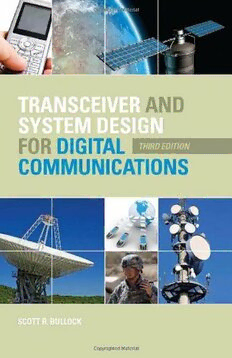Table Of ContentB
third edition
u
tRanSceiveR and SyStem deSign l
l
foR digital communicationS o
c
k
Now in a 3rd edition, this successful book trol, an intuitive approach to probability, jam-
provides an intuitive approach to transceiver ming reduction method using various adap-
design, allowing a broad spectrum of readers tive processes, global positioning systems ft tRanSceiveR and
oR
to understand the topics clearly. It covers a (GPS) data link, and direction-finding and in-
Ra
wide range of data link communication de- terferometers, plus a section on broadband
n
sign techniques, including link budgets, dy- communications and home networking. Var- d SyStem deSign
namic range and system analysis of receivers ious techniques and designs are evaluated iS
g
and transmitters used in data link communi- for modulating and sending digital data. Thus c
i
cations, digital modulation and demodula- readers gain a firm understanding of the pro- te foR digital
tion techniques of phase-shift keyed and cesses needed to effectively design wireless ai third edition
v
frequency hopped spread spectrum systems data link communication systems. l
e
using phase diagrams, multipath, gain con- cR communicationS
o
a
m
n
key featuReS
md
» Provides an understanding of concepts in wireless, data link, and digital communi-
uS
cation techniques for both commercial and military sectors.
ny
» Covers digital modulation, spread spectrum modulation and demodulation, link bud- S
i
gets, error detection and correction, probability applications, and a broad coverage ct
of all the elements that make up a digital modulated data link. ae
tm
» Includes extra topics such as: adaptive process to mitigate narrow band jammers
i
in a broadband communications link, GPS, multipath, and satellite communications. o
d
Also includes Link 16, JTRS, military radios, networking link budgets, Eb/No, BER, n
e
Pe, direct sequence spread spectrum transmitters, PN code generators, DSPs, AGC, S
S
pulsed matched filters, PPM, CDMA, carrier recovery, matched filters & sliding cor-
i
relators, eye pattern, phase detection, Gaussian processes, quantization error, anti- g
jam, adaptive filters, intercept receivers, GPS. n
ISBN 9781891121722
9 781891 121722 Scott R. Bullock
SciTech Publishing, Inc., Raleigh, NC www.scitechpub.com
P1:OSO/UKS P2:OSO/UKS QC:OSO/UKS T1:OSO
SPIB003-FM SPIB003-Bullock-v1 April8,2009 18:59
Transceiver and System
Design for Digital
Communications
i
P1:OSO/UKS P2:OSO/UKS QC:OSO/UKS T1:OSO
SPIB003-FM SPIB003-Bullock-v1 April8,2009 18:59
ii
P1:OSO/UKS P2:OSO/UKS QC:OSO/UKS T1:OSO
SPIB003-FM SPIB003-Bullock-v1 April8,2009 18:59
Transceiver and System
Design for Digital
Communications
Scott R. Bullock, P.E.
Third Edition
SciTech Publishing, Inc.
Raleigh, NC
iii
P1:OSO/UKS P2:OSO/UKS QC:OSO/UKS T1:OSO
SPIB003-FM SPIB003-Bullock-v1 April 8, 2009 18:59
c 2009bySciTechPublishingInc.
Allrightsreserved.Nopartofthisbookmaybereproducedorusedinany
formwhatsoeverwithoutwrittenpermissionexceptinthecaseofbrief
quotationsembodiedincriticalarticlesandreviews.Forinformation,
contactSciTechPublishing,Inc.
PrintedintheU.S.A.
109876543
ISBN13:9781891121722
SciTechPresident:DudleyR.Kay
ProductionDirector:SusanManning
ProductionCoordinator:RobertLawless
CoverDesign:KathyGagne
Thisbookisavailableatspecialquantitydiscountstouseaspremiums
andsalespromotions,orforuseincorporatetrainingprograms.Formore
informationandquotes,pleasecontact:
DirectorofSpecialSales
SciTechPublishing,Inc.
911PaverstoneDr.–Ste.B
Raleigh,NC27613
Phone:(919)847-2434
E-mail:[email protected]
http://www.scitechpub.com
LibraryofCongressCataloging-in-PublicationData
Bullock,ScottR.,1950-
Transceiverandsystemdesignfordigitalcommunications/Scott
R.Bullock.—3rded.
p.cm.
Includesindex.
ISBN978-1-891121-72-2(hbk.:alk.paper)
1.Radio–Transmitter-receivers–Designandconstruction. 2.Spread
spectrumcommunications. 3.Digitalcommunications.
I.Title.
TK6561.B8352008
621.384 131—dc22
2008017294
iv
P1:OSO/UKS P2:OSO/UKS QC:OSO/UKS T1:OSO
SPIB003-FM SPIB003-Bullock-v1 April8,2009 18:59
Tomylovingwife,Debi;
toCrystal,Cindy,Brian,Andy,andJenny;
andtomymother,Elaine.
v
P1:OSO/UKS P2:OSO/UKS QC:OSO/UKS T1:OSO
SPIB003-FM SPIB003-Bullock-v1 April8,2009 18:59
vi
P1:OSO/UKS P2:OSO/UKS QC:OSO/UKS T1:OSO
SPIB003-FM SPIB003-Bullock-v1 April8,2009 18:59
Contents
Preface xvii
AbouttheAuthor xxiii
TransceiverDesign 1
1.1 FrequencyofOperation................................................2
1.2 TheLinkBudget.......................................................4
1.3 PowerindBm..........................................................5
1.4 Transmitter............................................................9
1.4.1 PowerfromtheTransmitter...................................10
1.4.2 TransmitterComponentLosses................................10
1.4.3 TransmitterLineLossesfromthePowerAmplifierto
Antenna........................................................10
1.4.4 TransmitterAntennaGain.....................................11
1.4.5 TransmitterAntennaLosses...................................12
1.4.6 TransmittedEIRP.............................................13
1.5 Channel...............................................................14
1.5.1 Free-SpaceAttenuation........................................14
1.5.2 PropagationLosses............................................15
1.5.3 MultipathLosses...............................................16
1.6 Receiver...............................................................17
1.6.1 ReceiverAntennaLosses.......................................18
1.6.2 ReceiverAntennaGain........................................19
1.6.3 ReceiverLineLossesfromtheAntennatotheLNA...........19
1.6.4 ReceiverComponentLosses....................................20
1.6.5 ReceivedSignalPowerattheOutputtotheLNA..............21
1.6.6 ReceiverImplementationLoss.................................22
1.6.7 ReceivedPowerforEstablishingtheSNRofaSystem.........23
1.6.8 ReceivedNoisePower..........................................23
1.6.9 NoiseFigure...................................................23
1.6.10ReceivedNoisePowerattheDetector..........................25
1.6.11ReceiverBandwidth............................................26
1.6.12Received E/N attheDetector.................................27
b o
1.6.13ReceiverCodingGain..........................................28
1.6.14Required E/N .................................................28
b o
1.6.15LinkBudgetExample..........................................28
P1:OSO/UKS P2:OSO/UKS QC:OSO/UKS T1:OSO
SPIB003-FM SPIB003-Bullock-v1 April8,2009 18:59
viii CONTENTS
1.6.16SpreadSpectrumSystems.....................................32
1.6.17ReceiverSpreadingLosses.....................................32
1.6.18ProcessGain...................................................32
1.6.19ReceivedPowerforEstablishingtheSNRforaSpread
SpectrumSystem..............................................33
1.7 Summary.............................................................33
TheTransmitter 35
2.1 BasicFunctionsoftheTransmitter...................................36
2.1.1 Antenna........................................................36
2.1.2 Transmit/ReceiveControl......................................37
2.1.3 PowerAmplifier................................................38
2.1.4 Upconversion...................................................38
2.1.5 SumandDifferenceFrequenciesGeneratedin
theUpconversionProcess......................................40
2.2 VoltageStandingWaveRatio.........................................41
2.2.1 MaximumPowerTransferPrinciple...........................42
2.3 DigitalCommunications..............................................44
2.3.1 DigitalversusAnalogCommunications........................45
2.3.2 BasebandModulationofDigitalandAnalogSystems.........45
2.3.3 SoftwareProgrammableRadiosandCognitiveRadios.........46
2.4 DigitalModulation....................................................47
2.4.1 Phase-ShiftKeying.............................................48
2.4.2 BinaryPhase-ShiftKeying.....................................48
2.4.3 DifferentialPhase-ShiftKeying................................50
2.4.4 Quadrature(Quaternary)Phase-ShiftKeying.................50
2.4.5 OffsetQPSK...................................................52
2.4.6 HigherOrderPSK.............................................52
2.4.7 VariationsinPSKSchemes....................................54
2.4.8 (cid:2)/4DifferentialQPSK.........................................54
2.4.9 Differential8-LevelPSK.......................................54
2.4.1016-OffsetQuadratureAmplitudeModulation..................56
2.4.11PhasorConstellationsandNoiseImmunity...................57
2.4.12ContinuousPhasePSK........................................59
2.4.13SpectralRegrowth.............................................59
2.4.14MinimumShiftKeying.........................................60
2.4.15Frequency-ShiftKeying........................................62
2.4.16SidelobeReductionMethods...................................63
2.4.17IdealShapingFilter............................................63
2.5 DirectSequenceSpreadSpectrum....................................66
2.5.1 Frequency-HoppingSpreadSpectrum.........................67
2.5.2 SpreadSpectrum...............................................69
P1:OSO/UKS P2:OSO/UKS QC:OSO/UKS T1:OSO
SPIB003-FM SPIB003-Bullock-v1 April8,2009 18:59
CONTENTS ix
2.5.3 JammerResistance............................................69
2.5.4 DespreadingtoRealizeProcessGainintheSpread
SpectrumSystem..............................................72
2.5.5 MaximalLengthSequenceCodes..............................73
2.5.6 MaximalLengthPNCodeGenerator..........................74
2.5.7 MaximalLengthPNCodeTaps................................75
2.5.8 GoldCodes.....................................................75
2.5.9 OtherCodes....................................................76
2.5.10SpectralLinesintheFrequencyDomain......................76
2.6 OtherFormsofSpreadSpectrumTransmissions.....................77
2.6.1 TimeHopping..................................................77
2.6.2 Chirped-FM....................................................78
2.7 MultipleUsers........................................................79
2.7.1 OtherMethodsforMultiuserTechniques......................81
2.7.2 OrthogonalSignals.............................................81
2.7.3 QuadraturePhaseDetectionofTwoSignals...................82
2.7.4 OrthogonalFrequencyDivisionMultiplexing..................83
2.7.5 OtherOFDMTechniques......................................86
2.8 PowerControl.........................................................86
2.9 Summary.............................................................88
TheReceiver 91
3.1 SuperheterodyneReceiver............................................91
3.1.1 BasicFunctionsoftheReceiver................................92
3.2 Antenna...............................................................93
3.3 Transmit/ReceiveControl.............................................93
3.4 Limiters...............................................................94
3.5 ImageRejectFilter/BandRejectFilter................................94
3.6 DynamicRange/MinimumDetectableSignal.........................94
3.7 TypesofDR...........................................................97
3.7.1 AmplitudeDR..................................................97
3.7.2 FrequencyDR..................................................97
3.7.3 Single-ToneFrequencyDR.....................................98
3.7.4 Two-ToneFrequencyDR.......................................98
3.8 Second-andThird-OrderIntermodulationProducts..................99
3.9 CalculatingTwo-ToneFrequencyDR................................101
3.10 SystemDR...........................................................102
3.11 TangentialSensitivity...............................................104
3.12 Low-NoiseAmplifier.................................................105
3.13 Downconversion.....................................................107
3.14 SplittingSignalsintoMultipleBandsforProcessing................108
3.15 PhaseNoise..........................................................109

